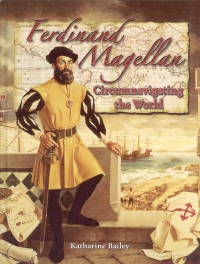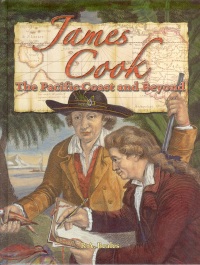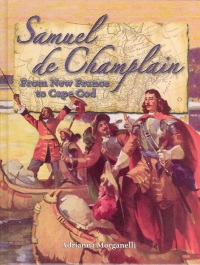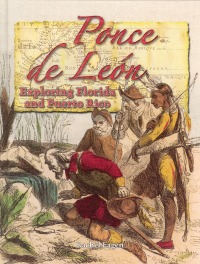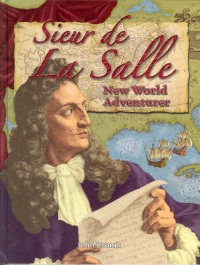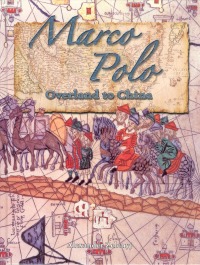| ________________
CM . . .
. Volume XII Number 18 . . . .May 12, 2006
excerpt:
Part of the now 10-volume “In the Footsteps of the Explorers” series, these titles, averaging 12 chapters each, detail the voyages of a number of European explorers. The books are identical in layout and include a table of contents, a glossary and an index. Coloured sidebars serve as timelines. There are abundant maps and illustrations in a variety of media - paintings, pen and ink line drawings and photographs - as well as excerpts from the explorers’ journals and recipes for dishes that would have been eaten on the voyages (e.g. sauerkraut to prevent scurvy) or at the places discovered by the explorers. The texts are written by different authors but in a very similar style to provide cohesiveness to the series. Beginning with some background information about previous explorations to give readers a sense of the historical period and events happening in the world, the books continue with facts about the featured explorer’s early life, detailed accounts of the voyages, the trials and tribulations of life at sea, the dangers and problems encountered, and the successes and failures of the expeditions. Each book ends with a double-page spread describing the explorer’s legacy. Many explorers were lured by the quest for valuable spices. Magellan was no exception, trying to find a westward sea passage from Spain to the Moluccas, or Spice Islands, located in present-day Indonesia. In Ferdinand Magellan: Circumnavigating the World, readers will learn about life at sea during the 1500s - the jobs of the crew members, the ships, the cargo for both survival and trade, and food rations - as well as early trading missions with native peoples in South America and Asia. Storms, mutiny, lack of food, shipwrecks, battles and hostile natives were just some of the hardships Magellan and his men faced. Though Magellan did not make it back to Spain with his crew (one ship of five and 18 out of the original 100 sailors survived the three-year journey), he was known as the man who captained the first fleet of ships to sail around the world, and his voyage was the first to discover the effects of trade winds in the Pacific Ocean. James Cook: The Pacific Coast and Beyond tells the story of Captain Cook, a British Royal Navy officer, whose journeys took him to New Zealand, Hawaii, Alaska and Australia. On each of his three Pacific voyages, scientists came along to observe and document new plant and animal species previously unheard of in England. Cook was sent to Tahiti to observe an eclipse, but secretly he was looking for the Unknown Southern Continent. On his second voyage, his two ships sailed through the Antarctic, then went on to Tahiti, Tonga, New Zealand, Easter Island, the New Hebrides and Caledonia. When he made his final voyage, Cook brought domestic animals to New Zealand and Tahiti. At that time, he claimed Christmas Island for England, became the first European to land in Hawaii and then sailed to Alaska. In this book, readers will find out about the navigational tools that Cook used, the lives of the Pacific peoples he encountered, specifically the Tahitians and the Maori, and about Cook’s contributions to mapmaking and navigation. Though he is credited with opening up the Pacific, many South Pacific islanders blame him, and expeditions like his, for destroying the lives of many indigenous people by bringing diseases, guns, war and alcohol to the South Pacific and forcing islanders off their lands. Champlain, known as the “Father of New France,” made 21 voyages across the Atlantic to North America to search for a water route to Asia and to find a site for French settlement. He was ordered to make reports and maps, to make peace with the natives and bring Christianity to them, and to search for gold and silver deposits. His voyages took him to the Caribbean - Guadaloupe, Mexico, Panama and Cuba - as well as to North America where he explored the St. Lawrence River. Samuel de Champlain: From New France to Cape Cod highlights Champlain’s establishment of French colonies in Acadia, life in the colony and the hardships, such as bitter winters, lack of food, and diseases, endured by the people. Also featured is information about the alliance he formed with the Huron and Algonquian people to ensure the success of future French fur-trading settlements, wars with the Iroquois, and his running of New France in what is now Quebec. Champlain’s major contribution to Canada was the establishment of the French culture and language in North America. Ponce de León was a Spanish conquistador, military commander and explorer who served as a page and a squire in his youth. His claim to fame is the discovery of Florida in 1513 and the Gulf Stream, and he was the first European to establish a colony in what is now known as Puerto Rico, serving as its first governor. He also searched for the legendary Fountain of Youth. In Ponce de León: Exploring Florida and Puerto Rico, there is information about his two voyages, the first being one of discovery and the second, for the purpose of colonization. As governor of Caparra, near Puerto Rico, he used the Taino natives to help build stone houses and plant crops, and established a cassava plantation. Then, while in search of Bimini, he actually sighted the Florida peninsula and explored the area now called the Florida Keys. Because of the lush vegetation and the fertile land he saw there, he asked the king of Spain’s permission to make a second voyage to Florida to start a colony. He brought 200 men and women, including doctors and priests, as well as domestic animals and seeds for agriculture, but the colony was abandoned after an attack by local natives. This title describes his three ships, life at sea, and the lifestyles of both the Taino and the Calusa Indians who were living in the area at the time. Eventually, both groups were overcome by the Spanish, not only in attacks, but also by the spread of measles, influenza and smallpox for which the native had no immunity. Today, Ponce de León’s legacy is evident in Puerto Rico, where Spanish is still the official language and Roman Catholicism, brought to the island by the Spanish, is the main religion. Even though the Taino have died out, their inventions of hammocks and barbecues are used worldwide. Recommended. Gail Hamilton is a teacher-librarian in Winnipeg, MB.
To comment
on this title or this review, send mail to cm@umanitoba.ca.
Copyright © the Manitoba Library Association. Reproduction for personal
use is permitted only if this copyright notice is maintained. Any
other reproduction is prohibited without permission.
NEXT REVIEW |
TABLE OF CONTENTS FOR THIS ISSUE
- May 12, 2006.
AUTHORS |
TITLES |
MEDIA REVIEWS |
PROFILES |
BACK ISSUES |
SEARCH |
CMARCHIVE |
HOME |
